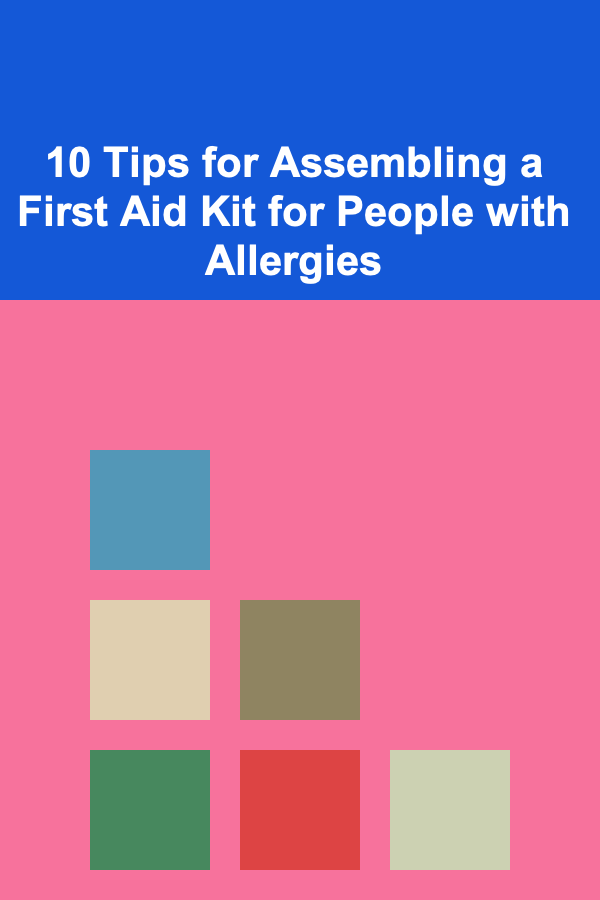
10 Tips for Assembling a First Aid Kit for People with Allergies
ebook include PDF & Audio bundle (Micro Guide)
$12.99$7.99
Limited Time Offer! Order within the next:

An allergy is an overreaction of the immune system to substances that are usually harmless, such as pollen, pet dander, certain foods, or insect stings. For people with allergies, having a well-prepared first aid kit is an essential part of managing their condition and reducing the risk of serious reactions. Whether you have a severe nut allergy, are prone to seasonal pollen allergies, or are sensitive to bee stings, your first aid kit should be tailored to your specific needs.
In this article, we'll explore the 10 best tips for assembling a first aid kit specifically designed for people with allergies. The right kit will not only help you manage minor allergic reactions but could potentially save your life in the event of a severe anaphylactic reaction.
Know the Specific Allergies and Triggers
Before you can effectively assemble a first aid kit for allergy sufferers, it's important to understand what types of allergies need to be addressed. Common allergens include:
- Food allergies (peanuts, tree nuts, shellfish, milk, eggs, etc.)
- Insect stings (bee stings, wasp stings)
- Pollen allergies (hay fever)
- Drug allergies
- Latex allergies
- Animal dander
Different types of allergies require different treatments, so it's crucial to understand which allergens are problematic for the person the kit is being assembled for. This will help you select the appropriate medications and supplies. For example, an individual with a peanut allergy will require different tools and medications than someone with seasonal pollen allergies.
Epinephrine Auto-Injectors (EpiPens)
For individuals with a history of severe allergic reactions (anaphylaxis), having epinephrine on hand is critical. Anaphylaxis can occur within minutes after exposure to an allergen, and it requires immediate treatment to prevent life-threatening complications. Epinephrine is the first-line treatment for anaphylaxis and should be administered as soon as possible.
When assembling an allergy-specific first aid kit, make sure to include at least one epinephrine auto-injector (like an EpiPen). If the person uses epinephrine regularly, it's a good idea to have a backup injector in case the first one is lost, expired, or used. Always check expiration dates to ensure the epinephrine is still effective.
Tip:
Keep the epinephrine auto-injector in a place that is easy to reach and make sure the person who might need it is familiar with how to use it. Consider training family members or friends on how to administer it in an emergency.
Antihistamines for Mild Allergic Reactions
Antihistamines are often the first line of defense for mild allergic reactions, such as sneezing, itching, rashes, or mild swelling. These over-the-counter medications help block histamine, a chemical released during an allergic reaction that causes symptoms like itching and swelling.
When assembling the kit, include oral antihistamines, such as:
- Diphenhydramine (Benadryl)
- Loratadine (Claritin)
- Cetirizine (Zyrtec)
These medications can provide relief from mild allergy symptoms and help prevent them from worsening. Keep in mind that some antihistamines cause drowsiness, so be sure to read the labels and select the appropriate one based on your needs.
Tip:
If you're assembling a kit for a child, make sure the antihistamines you include are appropriate for their age group, as children require different dosages than adults.
Topical Steroids for Skin Reactions
For people with allergies that cause skin reactions (such as hives, rashes, or swelling), having a topical steroid cream or hydrocortisone ointment in the kit can be extremely helpful. These products reduce inflammation and itching caused by allergic skin reactions.
Make sure the product you choose is appropriate for the type of skin reaction you may encounter. For example, hydrocortisone 1% is a common option for mild rashes, but if the reaction is more severe, a stronger medication may be needed.
Tip:
Be cautious when using topical steroids on broken or infected skin, and consult a healthcare provider for guidance if the reaction is severe or doesn't improve with treatment.
Saline Nasal Spray for Pollen Allergies
For people who suffer from seasonal allergies or hay fever , a saline nasal spray can be a valuable item to include in your first aid kit. Saline sprays help to clear mucus and allergens from the nasal passages, providing immediate relief from congestion and nasal irritation.
You can purchase pre-made saline sprays or create your own at home by mixing saltwater in a clean bottle. Keep in mind that saline sprays do not contain medications, so they are safe to use for anyone, including children and pregnant women.
Tip:
Be sure to clean the nozzle or container of the saline spray regularly to avoid contamination.
Insect Bite Relief
Insect bites, particularly from bees , wasps , and mosquitoes, can cause significant allergic reactions in some people. For those with insect allergies, having the right supplies to treat bites and stings is crucial.
Include the following in your kit:
- Antiseptic wipes for cleaning the bite or sting area
- Ice packs or cold compresses to reduce swelling
- Hydrocortisone cream for itching and inflammation
- Bee sting kits for more severe stings (often containing epinephrine or other treatments)
Tip:
If the person has a known severe allergy to bee stings or other insect bites, make sure the first aid kit contains epinephrine and ensure that the person carries it at all times.
A Checklist of Emergency Contacts
In addition to medications and remedies, it's essential to include a list of emergency contacts in your first aid kit. This list should contain:
- Personal doctor's contact information
- Allergist or specialist's information (if applicable)
- Local emergency services or poison control number
- A close family member or friend who can be contacted in case of an emergency
Having this information on hand will ensure that in the event of a severe allergic reaction, you can quickly contact the right people for assistance. You can even consider adding a medical alert card with this information, which can be carried in the first aid kit or on your person at all times.
Easily Accessible Instructions
For someone who is prone to allergic reactions, it's essential that they have clear, concise instructions for handling allergic reactions and using the supplies in the kit. Include a printed step-by-step guide that explains:
- How to use an EpiPen or epinephrine auto-injector
- How to administer antihistamines
- When to call for emergency help
- How to treat common allergic reactions
This will help the person or others around them act quickly and effectively in an emergency.
Tip:
If the person has specific medical needs or preferences, consider consulting with a healthcare provider to develop a more personalized plan.
Inhalers for Respiratory Allergies
Respiratory allergies can cause symptoms such as wheezing, shortness of breath, and tightness in the chest. For people with asthma or respiratory allergies , an inhaler (such as a bronchodilator or corticosteroid inhaler) is a must-have.
Be sure to include a rescue inhaler like albuterol for immediate relief of breathing difficulties. Keep in mind that inhalers require specific instructions for proper use, so make sure that the person knows how to use their inhaler effectively.
Tip:
Ensure that inhalers are stored properly to maintain their effectiveness and check expiration dates regularly.
Regularly Check and Replace Expired Items
An important, often overlooked, part of maintaining a first aid kit is regularly checking and replacing expired medications. Many allergy medications, including epinephrine auto-injectors and antihistamines, have expiration dates. It's essential to review your kit every few months to ensure everything is in working order.
Tip:
Create a schedule to check the contents of your first aid kit, and make sure that any expired items are replaced promptly.
Conclusion
Assembling a well-stocked and personalized first aid kit for people with allergies is a critical step in managing allergic reactions and ensuring safety in case of an emergency. From essential items like epinephrine auto-injectors and antihistamines to supportive tools such as saline sprays and insect bite relief, a comprehensive allergy first aid kit can provide peace of mind and quick relief in an allergy emergency. By following these tips, you'll be better equipped to handle allergy-related incidents, no matter the severity.
Reading More From Our Other Websites
- [Organization Tip 101] How to Use Binders to Organize Your Favorite Recipes
- [Home Cleaning 101] How to Clean Your Home After a Home Renovation
- [Organization Tip 101] How to Categorize Household Items for Efficient Inventory Management
- [Home Security 101] How to Choose the Best Home Security Camera System
- [Home Holiday Decoration 101] How to Use Candles to Add a Cozy Touch to Your Holiday Decor
- [Metal Stamping Tip 101] Choosing the Right Materials: Metals That Excel in Electronic Stamping Applications
- [Home Rental Property 101] How to Keep Your Home Rental Property Secure and Safe for Tenants
- [Personal Care Tips 101] How to Choose Soap for Maintaining Soft, Smooth Skin
- [Organization Tip 101] Step-by-Step Guide to Sealing Your Driveway Like a Pro
- [Screen Printing Tip 101] Best Ultra‑Fine Mesh Selections to Achieve Photographic Detail in Screen Printing

How to Make a Small Space Feel Bigger During Renovations
Read More
How to Sell Travel-Related Products and Merchandise: A Comprehensive Guide
Read More
How to Craft Daily Affirmations for Specific Anxiety Triggers
Read More
10 Tips for Streamlining Travel Arrangements for Executives
Read More
How to Automate Regression Testing with Python
Read More
10 Tips for Wildlife Photography on a Budget
Read MoreOther Products

How to Make a Small Space Feel Bigger During Renovations
Read More
How to Sell Travel-Related Products and Merchandise: A Comprehensive Guide
Read More
How to Craft Daily Affirmations for Specific Anxiety Triggers
Read More
10 Tips for Streamlining Travel Arrangements for Executives
Read More
How to Automate Regression Testing with Python
Read More